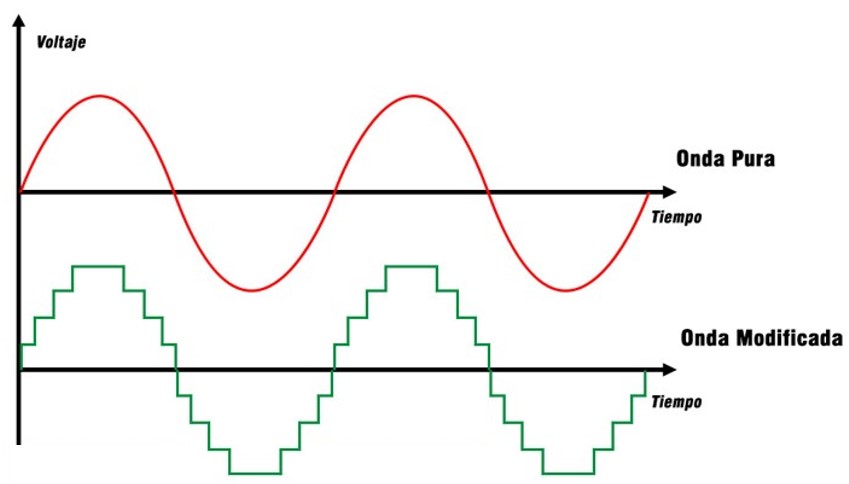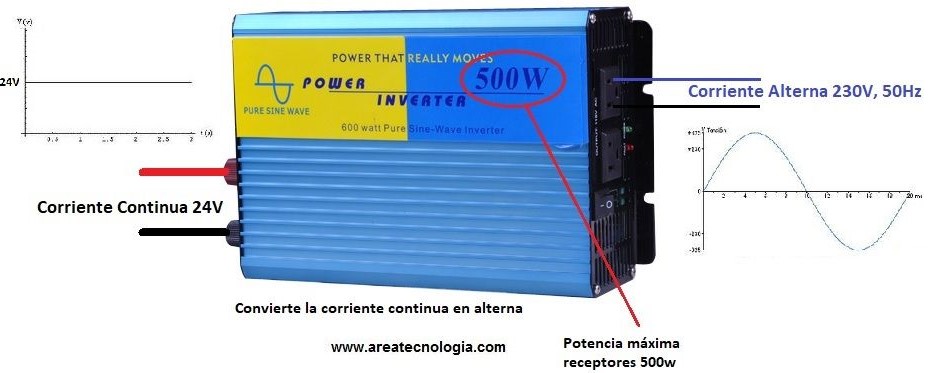The DC-AC inverter is the equipment that converts DC electricity into AC electricity, which is useful for powering your household appliances. Calculating the capacity of the DC/AC inverter is of great importance because it will determine the benefit you can derive from it.
Although there are various inverter technologies, they do not significantly affect the calculation, as the process is similar in all cases.
It’s essential to note that modified sine wave technology is not recommended for devices that rely on motors for operation. These devices include washing machines, dryers, air conditioners, and others.
On the other hand, pure sine wave inverters are suitable for all types of loads.
Therefore, we recommend checking out our post on Inverter technology: which one is right for your connected equipment to address any doubts you may have.
It’s worth mentioning that this article does not cover square wave inverters due to their characteristics and lower efficiency.
Regarding the technology to choose or the output waveform

The first step in sizing your inverter, whether you’re using solar panels or batteries as a power source, is to conduct a load analysis. This involves determining the type of loads you intend to power because the choice of inverter depends on the results of this analysis.
Therefore, if you will be powering non-inductive loads, meaning those without motors or moving parts, choose a modified sine wave inverter. It will be much more cost-effective than a pure sine wave inverter.
The latter is only essential if you have at least one load that includes moving parts. These loads include appliances like dishwashers, blenders, refrigerators, and others.
Capacity of the DC/AC inverter calculation for non-motor loads
Below, we present, step by step, how to perform this inverter sizing for non-motor loads.
Step 1: Calculate the sum of the loads
This means you should take the power consumption in watts (W) of each load. You can find this information on a small plate or label that is present on most appliances and devices. Next, we provide you with an example.

Once you have obtained this information for all the devices you plan to connect to the DC-AC inverter, proceed to calculate the total power consumption by summing them up. Here’s how it would look using the example you provided:
Let’s assume you have the following list of devices:
- 8 LED light bulbs at 15 W each: 8 x 15 = 120 W
- Desktop computer or PC: 300 W
- TV: 100 W
- 3 cellphone chargers at 20 W each: 3 x 20 = 60 W
Total Power Consumption (WTOTAL) = 120 + 300 + 100 + 60 = 580 W
So, the total power consumption of the connected devices is 580 W.
Step 2: Take into account the efficiency of the AC-DC inverter
For this type of loads, a modified sine wave DC-AC inverter is selected. If it is a quality unit, it should have a minimum efficiency of 85%. To ensure that the equipment can power this load with this efficiency, it should have the following capacity:
If the inverter has an efficiency of 85%, you need to compensate for the 15% power loss. Therefore:
WTOTAL1 = WTOTAL + 0.15 x WTOTAL = 580 + 0.15 x 580 = 667 W
It’s important to note that if the efficiency value is different, you should adjust the above calculation accordingly.
Step 3: The capacity of the inverter will be twice the calculated value
You should consider a reserve to anticipate unexpected load increases, spikes, and simultaneous startups, among other factors. To do this, take twice the previously calculated power:
Inverter Capacity (PINVERSOR) = 2 x 667 = 1334 W
You may not find an exact inverter with this capacity, so choose the next higher available option, which let’s assume is 1500 W. Therefore, you should purchase a modified sine wave inverter with a nominal capacity of 1500 W.
As you can see, selecting the inverter capacity is a relatively straightforward process. You just need to ensure you have the power consumption data for the devices you’ll be connecting and consider the appropriate correction factors.
By following this approach, you’ll be choosing a forward-thinking system. Whether you plan to expand your solar system by adding photovoltaic panels or increasing the loads to be powered in the future.
We invite you to visit energydcac, where you can find the best content on this topic. You’re sure to find it helpful!
Sources for images
- electroclub.com.mx
- energydcac.com

